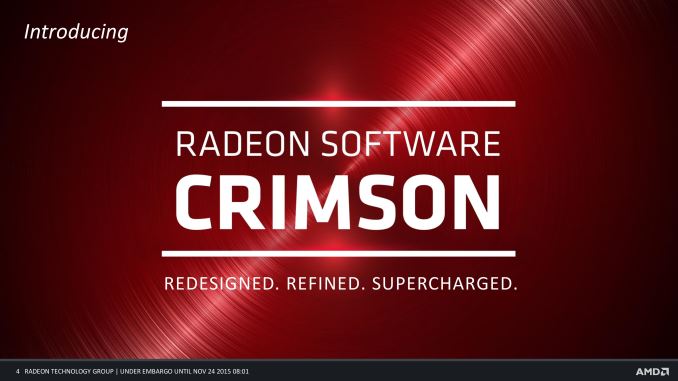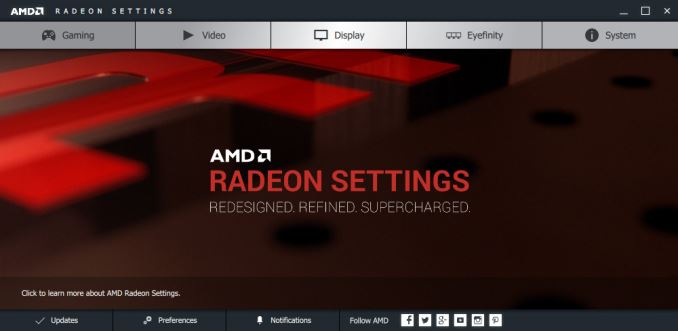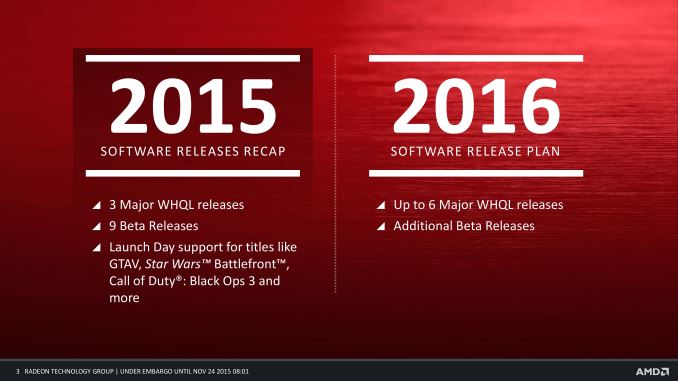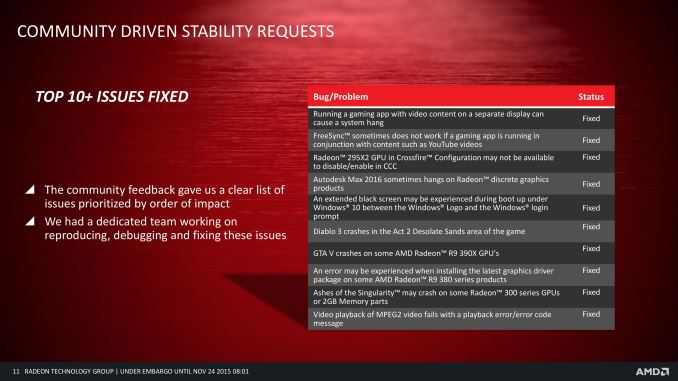AMD's Radeon Software Crimson Driver Released: New Features & A New Look
by Ryan Smith & Daniel Williams on November 24, 2015 8:00 AM EST
At the tail-end of 2014 AMD launched their Catalyst 14.12 driver set, better known as the Omega driver set. With Omega, AMD shifted their development process for the Catalyst driver set, focusing on delivering feature updates in fewer, larger updates while interim driver releases would focus on bug fixes, performance improvements, and adding new cards. The Omega release in turn was the first of these major releases, delivering a number of new features for Catalyst such as Virtual Super Resolution, preliminary support for FreeSync, and of course a number of performance improvements.
When briefing the press on Omega, one of AMD’s points was that if it was successful they were intending to make it a yearly release – in essence putting major feature updates on a yearly cadence – and after the reaction to Omega AMD has gone ahead and done just that. So launching today and serving as the cornerstone of AMD’s video driver plans for 2016 is this year’s major update, Radeon Software Crimson Edition. (Download)
Meet Radeon Software Crimson Edition 15.11
AMD and the Radeon Technologies Group first announced their plans for Radeon Software Crimson Edition back at the start of the month, in a preview/teaser of what they were working on. AMD’s initial preview focused on the UI aspects of Crimson, namely the new control panel application, Radeon Settings. And while AMD’s preview actually covered Radeon Settings in a fair bit of depth, like all good previews AMD kept everything going on under the hood for Crimson equally under wraps. As a result we have quite a bit to discuss today, with Crimson rolling out with a number of bug fixes and feature additions on top of the control panel overhaul AMD originally announced.
But before diving into matters, let’s talk about AMD’s announced release schedule for Crimson going forward. Like Omega before it, Crimson is an annual release and a cornerstone for AMD’s driver plans for the next year. Along with renaming their driver stack from Catalyst to simply Radeon Software, the Crimson branding will be sticking with this release cycle. Come late 2016, for their next major feature update the Crimson branding will be replaced with another red-themed name.
Meanwhile one point of criticism towards AMD in 2015 has been the limited number of WHQL certified driver releases for the year. AMD had plenty of beta releases over the year – averaging once a month despite the fact that the company stopped adhering to a fixed monthly release schedule in 2012 – however they only released 3 WHQL certified releases. WHQL certification is in and of itself a thorny issue – it is an additional layer of quality assurance, which is good, but it doesn’t cover game-specific bugs, which are the bulk of the bugs most gamers are going to run into – so while it’s useful it alone won’t make a driver good or bad. None the less AMD will be addressing the lack of WHQL certified releases for 2016.
AMD’s plans call for up to 6 driver releases to be WHQL certified next year, with additional beta releases as necessary as AMD already does today. Frankly the “up to” designation leaves AMD quite a bit of wiggle room in case they fall short, so it’s not a very solid promise. But on the other hand it’s legitimately difficult to plan for a specific number of WHQL releases a year in advance – one can’t predict bugs – so AMD does need some wiggle room in case they can’t meet that schedule. That said, if AMD wants to seriously address the complaints about the lack of WHQL releases in 2015 and retain their integrity, then they need to deliver on those 6 releases for 2016.
Speaking of quality assurance, AMD tells us that they have once again increased their QA testing, and stability is a top focus for 2016. With the Omega driver AMD ramped up both their automated and human testing to cover more test cases and system configurations, and for Crimson AMD has done this again.
As drivers approach (and in some cases exceed) the complexity of an operating system, comprehensive driver QA becomes increasingly invaluable, and Windows 10’s aggressive driver update mechanism will bring driver quality to the forefront. So although AMD has never not focused on driver quality and stability, there is always room for improvement. And particularly in AMD’s case, some of the Catalyst releases have shipped with some major issues despite AMD’s QA process improvements for Omega – the web browser memory leak comes to mind – so AMD definitely needs to improve their processes to prevent future issues.
As for Crimson in particular, AMD notes that they have knocked out a large number of bugs. AMD also notes that a number of these bugs came in and/or were prioritized via user feedback, so they’re asking that we remind everyone that AMD has a bug reporting form and that they’re encouraging anyone experiencing a driver bug to use it.














146 Comments
View All Comments
PixelBurst - Tuesday, November 24, 2015 - link
You seem to have fallen for Nvidia's trick of 'gameready' drivers. These aren't WHQL, these are beta drivers, they just don't say the word beta et Voila, users like yourself think they are doing God's work when they aren't.AS118 - Tuesday, November 24, 2015 - link
Yeah, that's just marketing spiel. If AMD called their beta drivers "cutting edge" or "performance optimized" drivers instead of "beta", I bet more people would try them and give them less flack for not making as many WHQL drivers.I've always said that Nvidia has had better marketing than AMD, and still think they do, which is why I think that even when performance and performance / value were equal or even if AMD was superior, that Nvidia always sold more.
I always try to tell AMD to up its marketing game as much as I can, as I don't want Nvidia to ever become a monopoly and I want the GPU and CPU races to stay competitive. I say this as a former Nvidia fanboy, who realized that no company is my friend and they all want my money, and that they'd probably misbehave if they'd ever become a monopoly. AMD too, but they're the underdog right now, which is why I support them lately. If they ever did become a monopoly or near-monopoly though, that'd change, of course.
jasonelmore - Tuesday, November 24, 2015 - link
Competition in the GPU Market drives Price CutsBut, I think Technology is pushing GPU Innovation and Performance.
VR and 4K alone are pushing GPU Engineers more than competition IMO
Dalamar6 - Wednesday, November 25, 2015 - link
Try getting an AMD card working in a rolling release linux distro like Arch, and then tell me that NVidia doesn't already have a monopoly.Oh wait, you can't. Not without having to disable what makes Arch, Arch, and using 9 months outdated software. And probably smashing a few keyboards/monitor/windows/glass objects/video cards in the process.
fluxtatic - Wednesday, November 25, 2015 - link
What is AMD's interest in getting drivers working in Arch? With the 5 billion Linux distributions out there, there are, what, a few thousand people that are really mad about this? AMD's not exactly what one would call "financially successful", so they're wise to pick their battles.looncraz - Wednesday, November 25, 2015 - link
Do it all the time, what's your problem?jasonelmore - Tuesday, November 24, 2015 - link
The drivers marked WHQL are all certified, i'm not sure what your saying.xenocea - Tuesday, November 24, 2015 - link
"Overall the average performance gain at 2560x1440 is just 1%. There are a couple of instances where there are small-but-consistent performance gains – Grand Theft Auto V and Grid: Autosport stand out here – but otherwise the performance in our other games is within the margin of error, plus or minus. Not that we were expecting anything different as this never was pitched as a golden driver, but this does make it clear that more significant performance gains are going be on a per-game basis."WCCF Tech performance test shows a different story.
"To quickly summarize the results that are below, Fiji see’s the largest increase in performance across all games tested, with between a 2-20% increase actually seen. This is actually astounding. But mostly, all tiers of card seem to have increased in performance, benefiting greatly from the new Crimson driver."
http://wccftech.com/amd-radeon-software-performanc...
nathanddrews - Tuesday, November 24, 2015 - link
PCPer tested the DX9 frame pacing fix for Skyrim and it showed an astounding improvement.http://www.pcper.com/files/imagecache/article_max_...
gamervivek - Tuesday, November 24, 2015 - link
wccftech's results look too good to be true with the BF4 results where they seem to be the only ones getting such a big increase. Either something is up with their setup or they're just making stuff up.